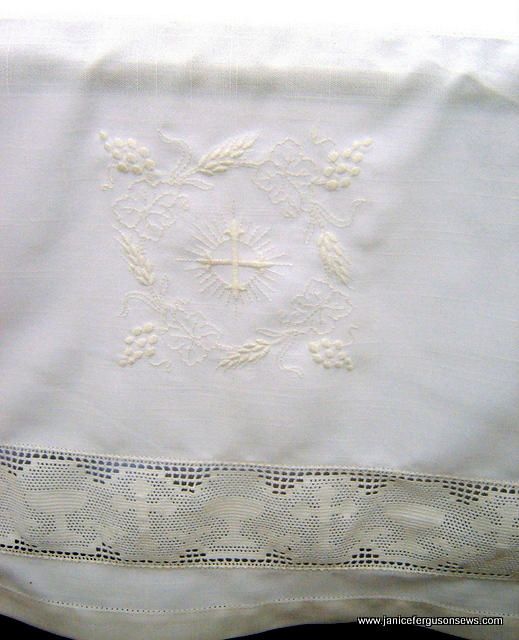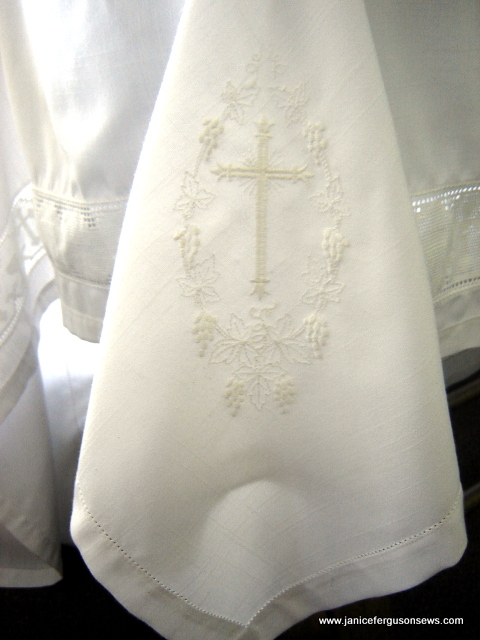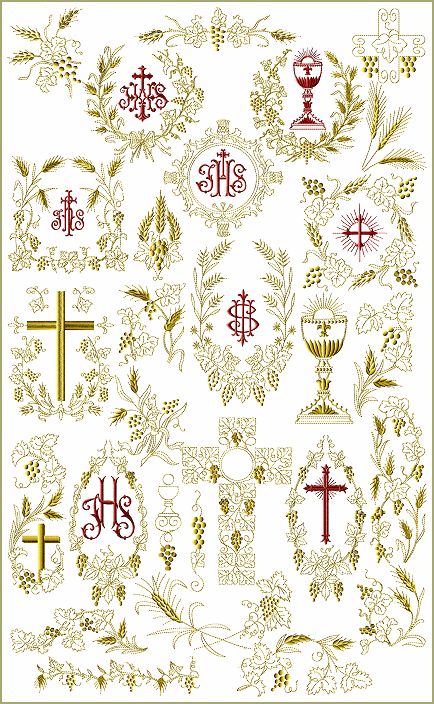I’ve just finished a two-piece set of communion linens to replace the plain white household tablecloth and napkin that has been in use at our church for some time. But I am very disappointed in the results. I hope one of you may have a suggestion to elevate this potentially beautiful set from “oh dear!” to “acceptable.”
Let me give you the background. A few years ago, I helped my Aunt Rheeta make a spectacular set for her church, using fine linen, this same liturgical lace, and the same design set. The pictures are not good at all, but you can see hers by clicking here.
Of course, I hoped to create an equally beautiful communion set, worthy of it’s sacred purpose, for my church.
The worship committee, who decides such things, requested that the fabric be “easy care.” Hmmmmm…I offered to launder the set after every use, but they were insistent that it be easy care.
First, I called Sally at Farmhouse Fabrics to see if she had a good quality 60″ linen blend. But she didn’t. After checking around, I reluctantly purchased a few inches of several sample fabrics from our local JoAnn’s.
On each of these, I rehearsed the pin stitch and entredeux stitches. My best results were on a 51″ wide piece of linen look poly. I thought that would work.
Because the cloth required 60″ of width, a piece was sewn on either side of the center panel. Entredeux was worked along the seam line, but looks very rough because it was stitched over two thicknesses. On real linen, that has always worked beautifully. But ultimately, puckers appeared.
Even though everything was flat while the hemstitching (both entredeux and pinstitch) was being worked with Stitch & Ditch stabilizer beneath the heavily starched, flat as a board fabric, after a very short time, it puckered.
Do you have any suggestions for eliminating the pucker? I’m thinking about using a liquid starch and pressing it stiff. But it seems that Florida’s humidity will ultimately overcome the starch.
Another problem is that the back of the lovely embroidery has scratchy dots of melted-but-not-disappeared plastic, even after many hours of picking it off with tweezers.
I learned that it is not a good idea to use iron-away stabilizer on a blend. If the iron is hot enough to melt the stabilizer, it will scorch the fabric. So the back of each embroidery is rough, at least until I have a few extra hours to pick it off. Do you have any suggestions for removing these bits?
All of the embroidery designs came from the Christian Symbols collection from ABC Embroidery Designs is absolutely gorgeous. And it is on sale now for $15, regularly $47!  The thread I’ve used is a favorite of mine, Robison-Anton’s 100% cotton 50 wt. thread. I first used it to monogram linen napkins and fell in love with the texture it gives.
When it came time to make the veil to cover the bread, I just went with quality 100% linen. I am satisfied with the 22″ hemstitched square with mitred corners to match the cloth. It lies perfectly flat and the washaway stabilizer left not a trace. It is embroidered in the center with a design of grapes and wheat.
I’m wrestling with whether or not to present this to the committee. Later this summer I could start another with good linen if they allow it. But sadly, I’ve used up all the liturgical lace on this project. If I had more, I would just start over. But this was a once in a lifetime purchase from Farmhouse Fabrics.
Any suggestions would be appreciated. I should probably just follow the advice of the sage contemporary philosopher, Mary Engelbreit.










12 responses to “Help!!! Communion Cloth Disappointment”